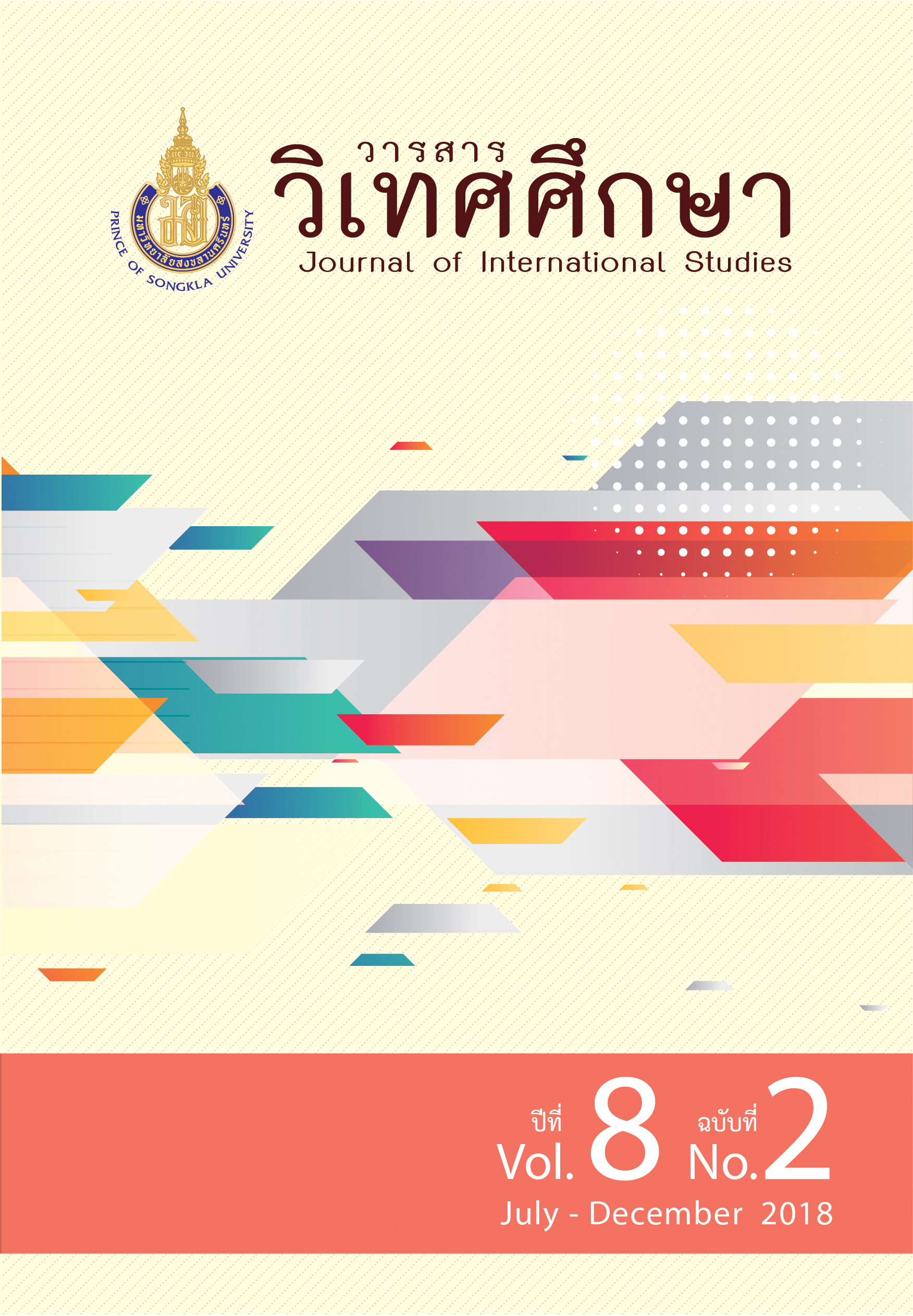Gap Year Tourists’ Motivation and Travel Pattern in Thailand
Main Article Content
Abstract
Tourist motivation and preferences are important components in studying a tourists’ behaviors fordesigning and developing tourism products andproducing an effective marketing campaign. Thisresearch aims to examine demographic characteristics,main motivations and the travel patterns of a gapyear tourist in Thailand. Questionnaires weredistributed at major tourist attractions, budget accommodations and transportation hubs in Bangkok, Phuket, Chiang Mai and Koh Samui. The 405 effective questionnaires were analyzed for this study. The findings have shown that the majority of gap year tourists were from English speaking countries and of western European origins, aged between 21-25years old and taking the gap year on employmentbreak. The main motivations were to learn andexperience another culture, to learn and experienceanother country, and to find thrill and adventure. These gap year tourists preferred backpacking in Thailand for around 2-4 weeks, and travelled to other countries. The most popular destination for respondents was Bangkok. In addition, the important tourism product were the hostels, street food, public transportation and plane flights.
Article Details
Statements and opinions expressed in articles herein are those of the authors and do not necessarily reflect the position of the editors or publisher.
Article, information, text, image, etc. which are published in Journal of International Studies, belong to Journal of International Studies. If anybody or any organization would like to use part or whole of them, they must receive written permission from Journal of International Studies before usage.
References
ABTA reveals top Gap Year destinations and provides advice to British teenagers heading overseas –ABTA. (2016). Abta.com. Retrieved 23 November 2016, from https://abta.com/aboutus/press/abta-reveals-top-gap-year-destinations-and-provides-advice-to-british-teena
Ansell, N. (2008). Third World Gap Year Projects: Youth Transitions and the Mediation of Risk. Environment And Planning D: Society And Space, 26(2), 218-240.
Claudia, M. (2010). The Distinctiveness of Youth Travel Product. Annales Universitatis Apulensis Series Oeconomica, 12(2), 638-648.
Coetzee, M., & Bester, S. (2010). The possible value of a gap year: A case Study. South African Journal Of Higher
Education, 23(3). 608-623.
Cohen, E. (2001). ‘Thailand in “touristic transition”,’ in. P. Teo, T.C. Chang and K.C. Ho (eds), Interconnected Worlds: Tourism in Southeast Asia, (PP. 155-175). London Routledge .
Cohen, E. (2006). Pai—A Backpacker Enclave in Transition. Tourism Recreation Research, 31(3), 11-27.
Cohen, S. (2011). Lifestyle Travellers: Backpacking as a way of life. Annals of Tourism Research, 38(4), 1535-1555.
Dayour, F. (2013). Motivations of Backpackers in the Cape Coast-Elmina Conurbation, Ghana. African Journal of Hospitality, Tourism and Leisure, 2(3), 1-12.
Dellaert, B., Ettema, D., & Lindh, C. (1998). Multi-faceted tourist travel decisions: a constraint-based conceptual framework to describe tourists' sequential choices of travel components. Tourism Management, 19(4), 313-320.
Egmond, T. (2007). Understanding Western Tourists in Developing Countries. Wallingford, UK: CABI.
Hampton, M. (1998). Backpacker Tourism and Economic Development. Annals Of Tourism Research, 25(3), 639-660.
Hampton, M. & Hamzah, A. (2016). Change, Choice, and Commercialization: Backpacker Routes in Southeast Asia. Growth and Change, 47(4), 556-571.
Howard, R. (2005). Khaosan Road: an evolving backpacker tourist enclave being partially reclaimed by the locals. International Journal Of Tourism Research, 7(6), 357-374.
Jarvis, J. & Peel, V. (2013). Tourists for hire: International working holidaymakers in a work based destination in regional Australia. Tourism Management, 37, 114-124.
Jeng, J.M. & D.R. Fesenmaier (1997). Facets of the Complex Trip Decision-Making Process. Annual Conference of the Travel and Tourism Research Association, 28, 31-41.
Jones, A. (2004). Review of gap year provision. Research Report No 555. Department of Education and Skills. University of London.
Kahl, C. & Ting, A. (2016) Self Discovery and Backpackers: A conceptual paper about liminal experience. International Journal of Religious Tourism and Pilgrimage, 4(1), 49-58.
Lumsden, M. & Stanwick, J. (2012). Who takes a gap year and why? (pp. 1-12). Adelaide: National Centre for Vocational Education Research Ltd.
Maslow, A. (1943). A theory of human motivation. Psychological Review, 50(4), 370-396.
Middelkoop, M. (2001). Mercin: a decision support system for outdoor leisure planning.
McDowall, S., & Wang, Y. (2009). An Analysis of International Tourism Development in Thailand: 1994–2007. Asia Pacific Journal of Tourism Research, 14(4), 351-370.
Noy, C. (2004). This Trip Really Changed Me. Annals of Tourism Research, 31(1), 78-102.
O’Reilly, C. (2006). From drifter to gap year tourist. Annals of Tourism Research, 33(4), 998-1017.
Paris, C. (2012). Flashpackers: An Emerging Sub-Culture?. Annals of Tourism Research, 39(2), 1094-1115.
Paris, C., & Teye, V. (2010). Backpacker Motivations: A Travel Career Approach. Journal of Hospitality Marketing & Management, 19(3), 244-259.
Pearce, P. & Foster, F. (2007). A “University of Travel”: Backpacker learning. Tourism Management, 28(5), 1285-1298.
Rabie, S. & Naidoo, A. (2016). The value of the gap year in the facilitation of career adaptability. South African Journal Of Higher Education, 30(3). 238-155.
Richards, G. & Wilson, J. (2004). The International Student Travel Market: Travelstyle, Motivations, and Activities. Tourism Review International, 8(2), 57-67.
Simpson, K. (2004). ‘Doing development’: the gap year, volunteer-tourists and a popular practice of development. Journal of International Development, 16(5), 681-692.
Sørensen, A. (2003). Backpacker ethnography. Annals of Tourism Research, 30(4), 847-867.
Sörensson, E. (2008). Making a living in the world of tourism. Umeå: Kulturgeografiska inst., Umeå univ. 46-47.
Uriely, N., Yonay, Y., & Simchai, D. (2002). Backpacking experiences. Annals of Tourism Research, 29(2), 520-538.
Williams, C. (2009). Thailand. Footscray, Vic.: Lonely Planet.
Wilson, J. & Richards, G. (2008). Suspending Reality: An Exploration of Enclaves and the Backpacker Experience. Current Issues In Tourism, 11(2), 187-202.
Woodside, A.G. & MacDonald, R. (1994). General System Framework of Customer Choice Processes of Tourism Services. Spoilt for Choice. Austria: Kultur Verlag.
Yamane, T. (1973). Statistics: An Introductory Analysis. Third edition. New York: Harper and Row Publication.


